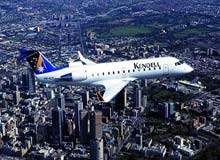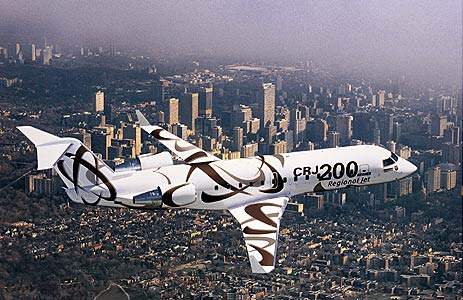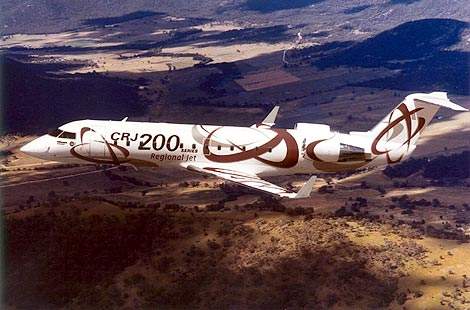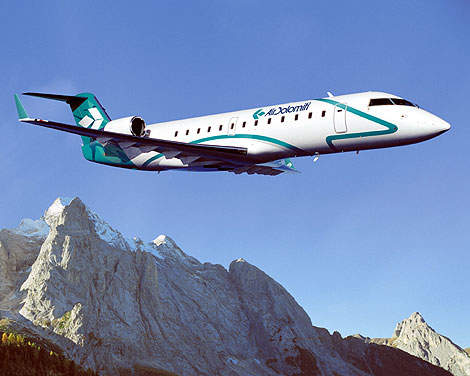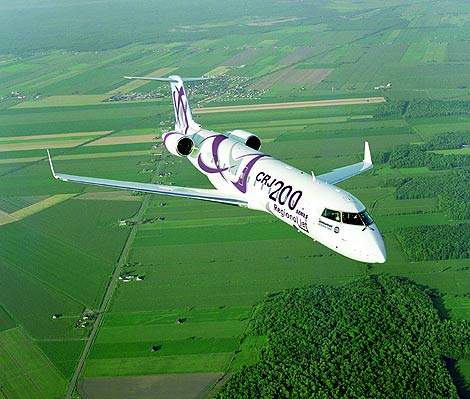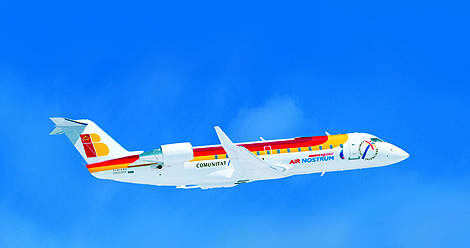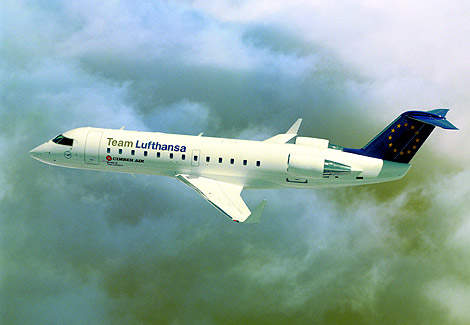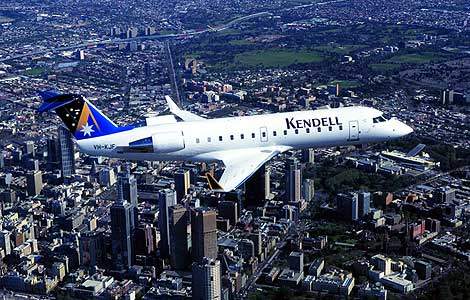The 50-seat Canadair Regional Jet 200 series was announced by Bombardier in 1995 and introduced into service in 1996. The CRJ200 replaced the first member of the family, CRJ100, which entered service in 1992. 709 CRJ200 regional passenger jets had been produced and delivered when production of the airliner was completed in January 2006. The CRJ200 continues to be manufactured as the airframe for the Challenger 850 corporate shuttle and executive jet.
The extended-range version, the CRJ200ER, has an increased maximum take-off weight (23,133kg) and an optional additional fuel capacity providing a maximum range of 3,046km. A longer-range version, CRJ200LR, has an increased maximum take-off weight (24,040kg) and a range of up to 3,713km.
The B variant, carrying the designations CRJ200B, CRJ200B ER and CRJ200B LR is fitted with CF34-3B1 engines for operation in hot and high conditions.
The Corporate Jetliner is the corporate executive shuttle variant accommodating 18 to 30 passengers. The Corporate Jetliner entered service in 1993. The special edition Corporate Jetliner, the SE version, entered service in 1995 with TAG Aeronautics. The cabin is customised for up to 19 passengers. The aircraft has a maximum take-off weight of 24,040kg and a range of over 5,556km. The aircraft is capable of providing a non-stop flight from Jeddah to London.
In May 2005, Bombardier launched the Challenger 850, a corporate shuttle based on the CRJ200LR. The Challenger 850 accommodates 50 passengers in Standard Cabin, 32 in Split Cabin and 27 in De Luxe Cabin configuration. The corporate shuttle entered service in March 2006. An executive version of the Challenger 850 entered service in November 2006.
In October 2005, Bombardier announced the temporary suspension of CRJ200 production, from January 2006. However in February 2006, Bombardier announced that production would restart in April 2006 to meet ‘present and anticipated demand’ for the Challenger 850 business jet.
Bombardier, with Eaton Aerospace, has certificated a redesigned flap actuator system for the CRJ200, to improve performance in cold weather. Retrofit of the flap upgrade began in August 2008.
The German Operating Aircraft Leasing (GOAL) signed an agreement with AviaAM Leasing in July to supply eight CRJ200 aircraft. The first CRJ 200 will be delivered in 2011 for lease to clients in Russian and CIS.
Orders and deliveries
Delta Connection of the US, through its carriers Atlantic Southeast Airlines (ASA), Comair and SkyWest Airlines, operates the largest fleet of CRJ200 jets with over 230 aircraft ordered and delivered, and Lufthansa CityLine of Germany is the largest European operator with 65 aircraft. Other operators include Air Wisconsin (70 aircraft), Air Canada (15), Atlantic Coast Airlines, Air Nostrum (32), Horizon Air, Mesa Air and Northwest Airlink (45).
In August 2006, Bombardier launched the CRJ200 PF (Package Freighter), with the announcement that West Air Europe of Sweden had signed a contract for the conversion of two CRJ200 to the freighter configuration.
CRJ200 flight deck
The two-pilot flight deck is fitted with a Rockwell Collins Pro Line 4 electronic flight and information system (EFIS) and an engine indication and crew alerting system (EICAS). The instrument displays include dual primary flight displays and dual multifunction displays.
The system has an integrated dual automatic flight control system, dual attitude heading reference system (AHRS) and a dual air data system.
The aircraft has Cat II operational capability. The addition of an optional Flight Dynamics Inc HGS 2100 HUD head up guidance system gives the aircraft Cat IIIa capability. The aircraft also has a terrain collision avoidance system (TCAS) and a Rockwell Collins digital weather radar. The flight data recorder is supplied by Lockheed Martin Fairchild.
The communications system is a dual VHF navigation and communications radio. HF and VHF radios and selective calling are optional communications. The windscreen and cockpit side windows are fitted with electric de-icing systems.
Design
The design of the CRJ200, which evolved from the Challenger 604 business jet, is for regional airline operations. The aircraft is equipped with high-efficiency engines giving a range up to 3,050km. The wings are transonic and are fitted with winglets for efficient high-speed flight.
The fuselage is of semi-monocoque design. The main cabin is nearly 15m in length with a centre-line width of 2.57m and can seat between 15 and 52 passengers.
The rear baggage compartment provides a baggage space of 9m³. The cabins and baggage compartment are pressurised and air-conditioned.
Engines
Two General Electric high efficiency CF34-8C1 turbofan engines provide 56.4kN thrust at take-off and 61.3kN thrust with auto power reserve. The engines are equipped with pneumatically operated
thrust reversers. The engine nacelles mounted on the sides of the rear section of the fuselage are developed and supplied by Bombardier Aerospace (Shorts Brothers) of Belfast.
Engine bleed air feeds the wing leading edge and engine intake cowling anti-icing systems.
There are two integral wing fuel tanks with a fuel capacity of 5,300l and an optional centre wing tank increases the fuel capacity by 2,780l. There are three gravity-refuelling points and one pressure-refuelling point on the wings.
A Honeywell GTCP 36-150 auxiliary power unit is installed in the rear fuselage section. Electrical power is provided by two 30kVA engine driven generators.
Landing gear
The aircraft is fitted with Dowty retractable tricycle-type landing gear. The landing gear is equipped with Aircraft Braking System wheels and multiple disc steel brakes, Goodyear tyres and Hydro Aire mkIII anti-skid units. The main landing gear retracts inward and the nose unit retracts forward.
Support
The Regional Aircraft division of Bombardier Aerospace, based in Toronto, Ontario, is responsible for marketing, sales, contracts and product support of the CRJ Series jet airliners.
The company’s training facilities include the Bombardier Aerospace Training Centre in Montreal and a facility in Berlin, Germany operated under agreement between Lufthansa, CAE and Bombardier
Aerospace.

